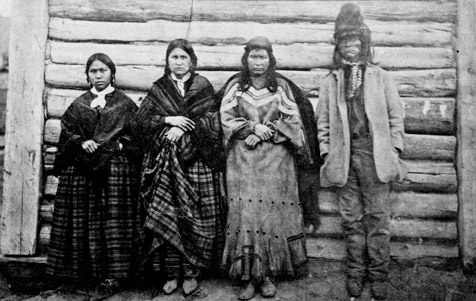Here’s a Lolo we can really believe in–the most famous one of all. A functionally illiterate halfbreed who possessed a remarkably strong personality, he was born sometime in 1798 of French and possibly Iroquois parentage, although he proudly called himself un Canadien. He filled successive roles as a tripman on transport brigades, then later as a trader, horse-breeder, miner, trapper, and hivernant.[1]A tripman was a voyageur or boatman (such as those Lewis and Clark hired as engagés at St. Charles); all of the enlisted men in the Corps of Discovery served in that capacity during the … Continue reading In 1828 the records of the Hudson’s Bay Company (HBC) post at Fort Kamloops on the Thompson River in New Caledonia (British Columbia) listed him as an interpreter.
Francis Ermatinger, the clerk in charge there, was married to an Indian woman who ran off one day with her Indian lover. Ermatinger sent his interpreter to find the man who had stolen his wife and deliver a dose of frontier justice—he was to cut off one of the thief’s ears. Lolo was equal to it.[2]Leroy R. Hafen, ed., The Mountain Men and the Fur Trade of the Far West, 10 vols. (Glendale, California: Arthur H. Clark, 1971), 9:162. In many native tribes a wife found guilty of adultry was … Continue reading
Mister-Captain-Saint-Paul-Jean-Baptiste-Chief-Lolo
Widely known and highly respected both by the Salishan-speaking tribes of the Canadian interior—especially the nearby Shuswaps—and by the field managers of the HBC, Lolo negotiated a durable balance of power and mutual benefit between the two forces. The Englishman W. B. Cheadle (1836-1910), who toured the Canadian interior and met Lolo in 1863, observed that the colorful halfbreed spoke “a curious mixture of French, English & Indian,” and could swear effusively if not always understandably in his own French jargon. Lolo’s name was sometimes spelled Leolo, possibly reflecting a variant pronunciation. One of his daughters, Sophia, who for some unknown reason he occasionally called Martha, married John Todd (1794-1882), the HBC’s chief trader at the Thompson River Post.[3]C Beyk, John Todd: Rebel in the Ranks (Victoria, B.D.: Horsdal & Schubert, 1995), 142. G. D. Brown, “A further note on Captain St. Paul,” British Columbia Historical Quarterly, Vol. … Continue reading
This Lolo’s given name was Jean-Baptiste, one of the most common baptismal names among half-breed voyageurs in those days. He was later called St. Paul—either a nickname or a new baptismal name. HBC traders who knew him sometimes embellished his growing string of titles with the honorifics “Mister” and “Captain,” occasionally piling them up, as in “Mister Captain Saint Paul,” etc. After being flogged for some unmentioned offense by the hateful HBC clerk at Fraser Lake, for which the innocent Lolo’s Shuswap friends threatened retaliation, the company compensated Lolo with the quasi-official title “Chief.” There is no evidence that he was ever called Lawrence by anyone.
The exceptional Mister-Captain-Saint-Paul-Jean-Baptiste-Chief-Lolo spent his last years in “reduced circumstances,” died on 15 May 1868 at age 70, and was buried at the Thompson River HBC Post. As far as anyone knows, he never got as far south as Lewis and Clark’s “Travelers’ Rest Creek.”
Memorial?
Four years before Jean-Baptiste Lolo’s death his name appeared on British Admiralty Chart 580, identifying a mountain on the west side of Quadra Island, overlooking Seymour Narrows, north of the town of Campbell River, off the east coast of Vancouver Island. Was that in memory of him, or of some other local figure of less certain lineage with the same unexplainable name and an equally legendary reputation?
Notes
| ↑1 | A tripman was a voyageur or boatman (such as those Lewis and Clark hired as engagés at St. Charles); all of the enlisted men in the Corps of Discovery served in that capacity during the expedition. An hivernant or winterer was willing to spend his winters confined in isolated posts in the distant interior, trading goods for furs under the supervision of a commis, or apprentice clerk, who was working toward becoming a bourgeois, or proprietor of a trading post. Jim Blanchard, ed., A Thousand Miles of Prairie: the Manitoba Historical Society and the History of Western Canada (Winnipeg: University of Manitoba Press, 2002). Grace Lee Nute, The Voyageur, reprint (St. Paul: Minnesota Historical Society, 1955), 5. |
|---|---|
| ↑2 | Leroy R. Hafen, ed., The Mountain Men and the Fur Trade of the Far West, 10 vols. (Glendale, California: Arthur H. Clark, 1971), 9:162. In many native tribes a wife found guilty of adultry was punished by the amputation of the tip of her nose. The Lolo who discharged Ermatinger’s retribution is the only one mentioned in Hafen’s monumental study of the northwest fur trade. |
| ↑3 | C Beyk, John Todd: Rebel in the Ranks (Victoria, B.D.: Horsdal & Schubert, 1995), 142. G. D. Brown, “A further note on Captain St. Paul,” British Columbia Historical Quarterly, Vol. III (1939), 223-24. G. D. Brown and W. K. Lamb, “Captain St. Paul of Kamloops,” BCHQ, Vol. III (1954), 115-27. Richard Charles Mayne, Four Years in British Columbia and Vancouver Island: an Account of their Forests, Rivers, Coasts, Gold Fields, and Resources for Colonisation (London: John Murray, 1862), 119-20. |

